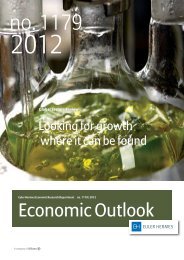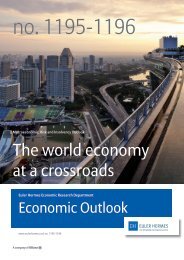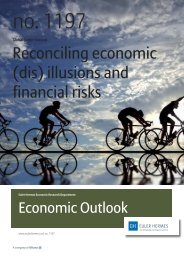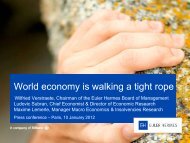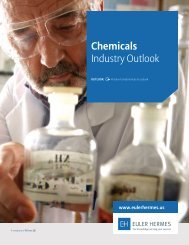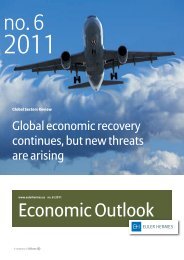Reindustrialization in USA - Euler Hermes
Reindustrialization in USA - Euler Hermes
Reindustrialization in USA - Euler Hermes
Create successful ePaper yourself
Turn your PDF publications into a flip-book with our unique Google optimized e-Paper software.
Economic Outlook n° 1187 | Special Report | The <strong>Re<strong>in</strong>dustrialization</strong> of the United States<strong>Euler</strong> <strong>Hermes</strong>Cash hoard <strong>in</strong>st<strong>in</strong>ct: debunk<strong>in</strong>g the mythClearly the U.S. is fall<strong>in</strong>g beh<strong>in</strong>d <strong>in</strong>critical R&D programs. So how will theU.S. <strong>in</strong>crease its <strong>in</strong>vestment <strong>in</strong> R&Dspend<strong>in</strong>g? What policies can the federalgovernment undertake to encouragethis effort? An exam<strong>in</strong>ation of currentbus<strong>in</strong>ess practices reveals somepossibilities.u U.S. manufacturers have grown their profits rapidlyover the past decade, largely due to <strong>in</strong>creasedproductivity. Yet over the same period, manufacturershave <strong>in</strong>creased <strong>in</strong>vestment much more slowly,and employment has actually fallen <strong>in</strong> the sector.Clearly, U.S. manufacturers need to resume a fasterpace of <strong>in</strong>vestment to become more competitive <strong>in</strong>the global marketplace. Profits need to be re-distributedto promote <strong>in</strong>vestment.Figure 29 below shows the growth <strong>in</strong> corporateand non-corporate bus<strong>in</strong>ess profits as a percentageof total assets. The ris<strong>in</strong>g profits are clearly evidenthere also, but this chart breaks the profits down <strong>in</strong>todividends and undistributed profits. It is evident thatover the past decade, manufacturers have paid outdividends at approximately the same rate, but theyhave more than tripled the portion of profits whichrema<strong>in</strong> undistributed. Where have the undistributedprofits been allocated on balance sheets?u Figure 30 below shows the composition of thebalance sheet of all corporate and non-corporatebus<strong>in</strong>esses. As shown by the blue l<strong>in</strong>e, contrary topopular belief, corporations are not hoard<strong>in</strong>g cashand other liquid assets on their balance sheets. Theproportion of liquid assets as a percentage of totalassets has barely budged from a low of 5.8% to ahigh of 7.3% to the current value of 6.4%. Instead, theundistributed profits went to pay down liabilities andto <strong>in</strong>crease net worth. These efforts have occurred <strong>in</strong>two dist<strong>in</strong>ct periods. After the tech bubble burst andequity values plummeted, bus<strong>in</strong>esses began rebuild<strong>in</strong>gnet worth and par<strong>in</strong>g down liabilities. Then thef<strong>in</strong>ancial crisis started to emerge <strong>in</strong> 2007, drasticallymark<strong>in</strong>g down the value of f<strong>in</strong>ancial assets, lower<strong>in</strong>gnet worth and <strong>in</strong>creas<strong>in</strong>g liabilities. After 2009, bus<strong>in</strong>essesonce aga<strong>in</strong> undertook the task of restor<strong>in</strong>gfiscal prudence to their balance sheets, reduc<strong>in</strong>g liabilities,and rebuild<strong>in</strong>g net worth. The f<strong>in</strong>ancial crisisand the great recession pushed bus<strong>in</strong>esses <strong>in</strong>to the“risk aversion” mode to rebuild their balance sheetsand make <strong>in</strong>vestment a secondary priority.u The good news is that although this risk aversionstrategy is still <strong>in</strong> place, it has been eas<strong>in</strong>g. Bankshave started to make commercial and <strong>in</strong>dustrialloans aga<strong>in</strong>. Consumer confidence is on the rise. Thehous<strong>in</strong>g market may have bottomed, and employmenthas firmed <strong>in</strong> recent months, although it is wellbelow the rate of job creation needed to bolster theanemic recovery. Expectations are that all of thesetrends will cont<strong>in</strong>ue and that bus<strong>in</strong>esses will start to<strong>in</strong>crease their risk appetite such that profits will beused less to bolster the balance sheet and more to<strong>in</strong>crease <strong>in</strong>vestment. • • •29. Distribution of Profits as a % of Assets30. Net Worth, Liabilities, and Liquid Assets as a % of Total Assets6%profits6%try<strong>in</strong>g to buildnet worth....f<strong>in</strong>ancial crisis drovenet worth down...try<strong>in</strong>g to buildnet worth aga<strong>in</strong>...net worth5%5%Liabilities4%undistributed profits4%liabilities try<strong>in</strong>gto de-lever ...f<strong>in</strong>ancial crisis droveasset values down...try<strong>in</strong>g tode-lever aga<strong>in</strong>...3%3%2%dividends2%1%1%5.8% liquid asset - no cash hoar 7.3% 6.4%liquid assets0%2000 01 02 03 04 05Source: Federal Reserve060708091011Q1 2012Q2 20120%2000 01 02 03 04 05Source: Federal Reserve060708091011Q1 2012Q2 201231



